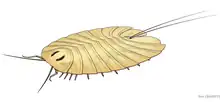Kodymirus
Kodymirus is a genus of Early Cambrian arthropod, known from the Czech Republic, which bears some resemblance to eurypterids and aglaspidids. Although it possessed great appendage-like raptorial arms, it was not homologous with those of megacheirans, and was instead a member of Vicissicaudata, closely related to aglaspidids. It is part of a small and low-diversity Paseky Shale fauna group, which dwelt in brackish waters.[1]
| Kodymirus Temporal range: Cambrian Series 2 | |
|---|---|
 | |
| Artist's restoration | |
| Scientific classification | |
| Domain: | Eukaryota |
| Kingdom: | Animalia |
| Phylum: | Arthropoda |
| (unranked): | †Artiopoda |
| (unranked): | †Vicissicaudata |
| Genus: | †Kodymirus Chlupáč & Havlíček, 1965 |
| Species: | †K. vagans |
| Binomial name | |
| †Kodymirus vagans Chlupáč & Havlíček, 1965 | |
Description
Kodymirus was a small predator at 80 mm (3.1 in) long. Its distinctive feature is pair of large, serrated raptorial appendages. These appendages appear convergent to those of megacheirans and radiodonts, but are not homologous as they postantennular, suggesting raptorial arms evolved multiple times in Cambrian arthropods.[2]
Kodymirus is an enigmatic arthropod, and its precise taxonomic affinity remains uncertain. It was initially believed to be an early eurypterid and later a megacheiran, but today it is best considered to be a stem-group or ally of the aglaspidids.[2][1] Its basipods closely resembles those of Emeraldella,[2] and is suggested to be related to Beckwithia due to the presence of axial spines.[3]
Paleoecology
Kodymirus inhabited the Paseky Shale, within the modern day Czech Republic, which may be a shallow marine environment or brackish estuary.[2][4] Trace fossils from the Shale have been interpreted as Kodymirus raking its claws along the sediment while swimming, disturbing benthic prey buried beneath the muck. This would make Kodymirus the earliest known arthropod predator in the intertidal zone.[2]
References
- Chlupáč, I. "Lower Cambrian arthropods from the Paseky Shale (Barrandian area, Czech Republic)". Journal of the Czech Geological Society. 40 (4): 9–36. Retrieved 2009-06-06.
- Lamsdell, James C.; Stein, Martin; Selden, Paul A. (2013-09-01). "Kodymirus and the case for convergence of raptorial appendages in Cambrian arthropods". Naturwissenschaften. 100 (9): 811–825. doi:10.1007/s00114-013-1081-y. ISSN 1432-1904.
- Ortega-Hernández, O; Legg, A; Braddy, J (2014). "The phylogeny of aglaspidid arthropods and the internal relationships within Artiopoda (project)". MorphoBank datasets. Retrieved 2022-09-28.
- "Ichnotaxonomy of the Cambrian Spence Shale Member of the Langston formation, Wellsville Mountains, Northern Utah, USA". Paleontological Contributions. 2018. doi:10.17161/1808.26428. ISSN 1946-0279.



